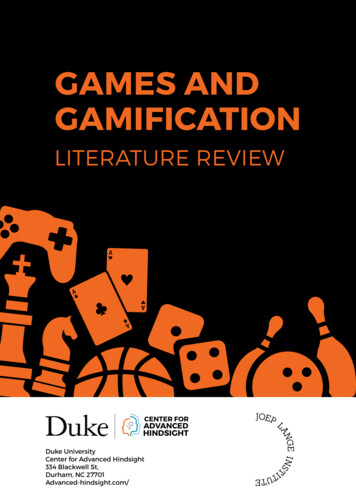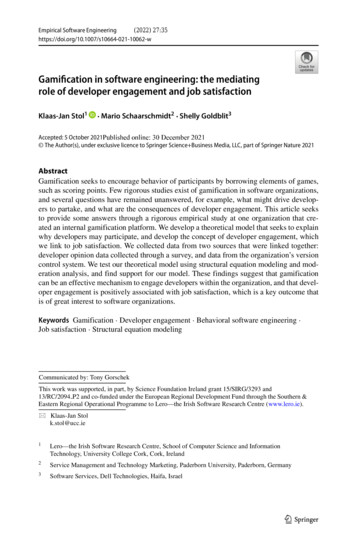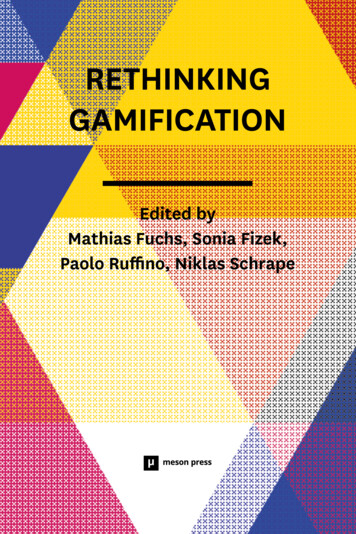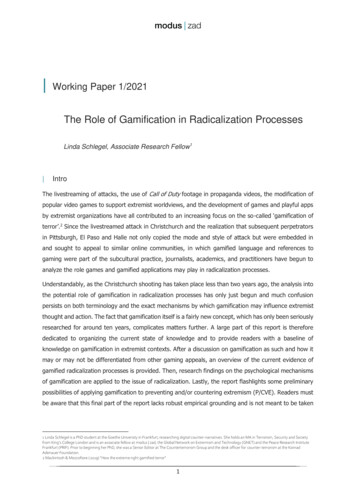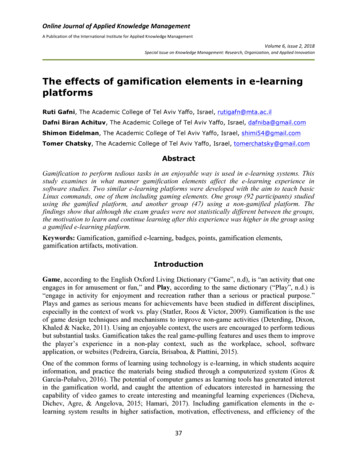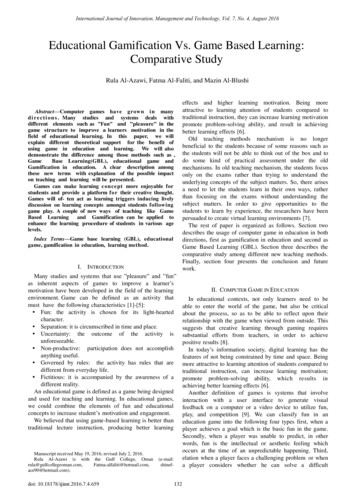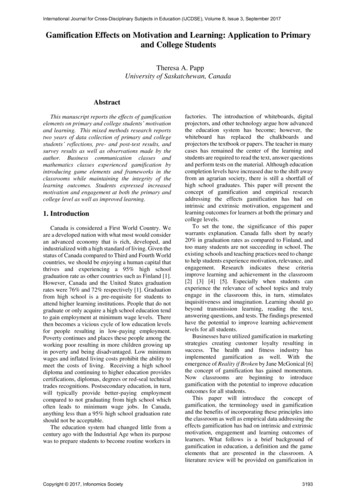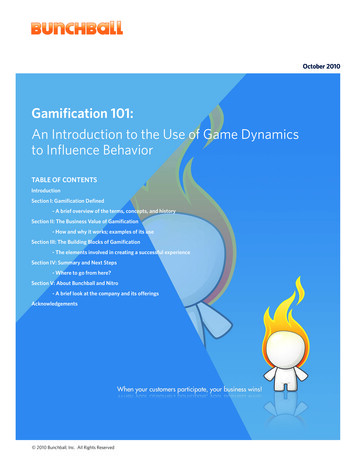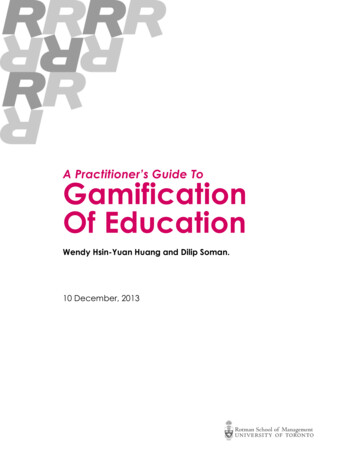
Transcription
A Practitioner’s Guide ToGamificationOf EducationWendy Hsin-Yuan Huang and Dilip Soman.10 December, 2013
2Research Report SeriesBehavioural Economics in ActionRotman School of ManagementUniversity of TorontoROTMAN SCHOOL OF MANAGEMENT
3Correspondence and AcknowledgementsFor questions and enquiries, please contact:Professors Dilip Soman or Nina MažarRotman School of ManagementUniversity of Toronto105 St. George StreetToronto, ON M5S 3E6Email: dilip.soman@rotman.utoronto.ca; nina.mazar@rotman,utoronto.caPhone Number: (416) 946-0195We thank Poornima Vinoo, MinXuan Lee, and Audrey Tan for comments on previous drafts. This report is inspired by the work of Jane McGonigal, Ray Wang andGabe Zicherman.We also thank Ben Leong, Michael Wu, Peter Vasil, Kim Ly and Min Zhao for multiple discussions and insights. Our validation phase involved consultation withthought leaders and experts from Constellation Research and PlayMoolah.ROTMAN SCHOOL OF MANAGEMENT
4Table of Contents1. Introduction . 52. What is Gamification . 63.Applying Gamification in Education . 73.1 Step 1: Understanding the Target Audience and the Context. 73.2 Step 2: Define Learning Objectives . 93.3 Step 3: Structuring the Experience . 93.4 Step 4: Identifying Resources . 113.5 Step 5: Applying Gamification Elements . 133.6 Recap . 153.7 Limitations and Discussion . 154. Gamification in Education: Case Studies . 164.1 Undergraduate Education – JFDI Academy . 164.2 Consumer Education – Healthcare University . 184.3 Corporate Training Education – Deloitte Leadership Academy . 194.4 Financial Literacy Education – PlayMoolah . 204.5 Social Responsibility Education – Recyclebank . 225. Conclusion . 24ROTMAN SCHOOL OF MANAGEMENT
51. INTRODUCTIONOne specific goal that behavioural scientists have in helping people attain betteroutcomes is to design interventions that get people engaged in activities such thattheir likelihood of completion is increased. In the world of “nudging” these interventions take the form of small changes in context that might have large outcomes. Inaddition, the effects of nudging can often be complemented with interventions thatare longer lasting in nature – interventions that increase longer term adherence to atask at hand. In this report, we focus on one such set of interventions collectivelyknown as gamification.Motivation and engagement are usually considered prerequisites for the completionof a task or encouragement of a specific behaviour. In education, the reasons fordrop-outs or low performance include boredom or lack of engagement, a patternof escalating absenteeism where each absence makes the person less willing to return to school, and most importantly, being distracted by technology such assmartphones and the Internet.1 Employee training programs face similar challenges,due to minimal interest and attention.2 This situation is usually acerbated by comprehension issues and group hostilities that lead to stress and unhappiness, which in turnhinder absorption of information and the effectiveness of training programs.3In today’s digital generation gamification has become a popular tactic to encourage specific behaviours, and increase motivation and engagement. Though commonly found in marketing strategies, it is now being implemented in many educational programs as well, helping educators find the balance between achieving theirobjectives and catering to evolving student needs.The intent of this report is to define gamification, deconstruct the process of gamifying a learning program, explore the limitations, and review successful implementations of gamification. We focus on learning programs in this report for several reasons.They key reason, though, is that we see education initiatives as a good companionto nudging programs in many areas of welfare (e.g., financial literacy, health education, consumer learning, disclosures) and hence a key challenge for policy-makers aswell as those on the ground delivering these programs. However, as the reader willdiscern, the framework we have developed for gamification of education is fertileand can be extended easily to other domains where interventions to increase engagement and retention are desired.ROTMAN SCHOOL OF MANAGEMENT
62. WHAT IS GAMIFICATION“Fun can obviously change behaviour for the better”4 is the statement that surroundsThe Fun Theory initiative by German automotive company, Volkswagen. Whether it isencouraging drivers to buckle their seat belts or citizens to recycle and lower therates of littering, Volkswagen puts a twist on these mundane tasks to make it fun.One of their initiatives that went viral, was the Piano Staircase at the Odenplan subway in Stockholm, Sweden. Each step of a staircase in the subway was setup to playa musical note when it was stepped on. At the end of the campaign, the resultsshowed that 66% more people used the musical stairs over the escalator.5 This is aprime example of gamification, and is a common tactic that companies are using intheir marketing strategies.A quick look at the video game industry over the past few years shows explosivegrowth as a result of increased access to Internet and smartphones. According toESA’s 2013 Essential Facts about the Computer and Video Game Industry, 58% ofAmericans play video games, spending a total of 20.77 billion dollars in 2012. 6 Gamers have a distinct characteristic where they strive to be on the verge of what JaneMcGonigal mentions as an ‘epic win’ during her TED Talk in 2010. These gamers havefour common factors: urgent optimism, social fabric, blissful productivity, epic meaning, and that ultimately makes them super empowered hopeful individuals. 7“You create these communities around the game that do an incredible amount ofintellectual work, and when they’re done with the work, they will leave the gameand go to another game that’s more challenging. Can you imagine if we had thatkind of environment in classrooms?”– Constance Steinkuehler SquireAssociate Professor in digital media at the University of Wisconsin-MadisonIn real life, individuals do not feel that they are as good as they are in games. Whenconfronted with obstacles, people may feel depressed, overwhelmed, frustrated orcynical; feelings that are not present in the gaming environment. They also prefer instant gratification to keep themselves engaged and motivated. And this, is wheregamification steps in. In fact, gamification guru, Yu-kai Chou defines gamification as“the craft of deriving all the fun and addicting elements found in games and applying them to real-world or productive activities”, while Ray Wang, CEO & Principal Analyst of Constellation Research, Inc., describes it as a “series of design principles, processes and systems used to influence, engage and motivate individuals, groups andcommunities to drive behaviours and effect desired outcomes.”8ROTMAN SCHOOL OF MANAGEMENT
73. APPLYING GAMIFICATION IN EDUCATIONWhile the concept of gamification may be simple, effectively gamifying a conceptisn’t. However, it can be simplified, by following a five-step process:Understanding theTarget Audienceand the ents3.1 Step 1: Understanding the Target Audience and the ContextWho is the target audience, and what is the context that surrounds the educationprogram?A key factor that determines the success of an education program, is a good understanding of who the student is. This combined with the context in which the programis being delivered, will help in designing a program that empowers the student toachieve the objective of the program.While an analysis of the target audience will help you determine factors like agegroup, learning abilities, current skill-set, etc., analysing the context can provide youwith details of the student group size, environment, sequencing of skills, and the timeframe. For example, if the learning program is held right before lunch, students maylack focus due to hunger. If the course is a prerequisite to another course that thestudent is really interested in, s/he may have more motivation to accomplish this prerequisite course.Some other questions to be considered include:ROTMAN SCHOOL OF MANAGEMENT
8What is the duration of the learning program?Where is the program being conducted? E.g. classroom, office, home, etc.Is it a group or a one-on-one setting?If it’s a group setting, what is the group-size?These questions help the instructor define the possible ‘pain points’ in the learningprogram, and work around them.A pain point is defined as a factor that prevents a student from advancing throughthe learning program and/or achieving the objectives. Pain points can differ depending on the student’s age, background, or the field they are in. For example, thepoor quality of assignmentsbeing submitted, could beattributed to a number ofpain points: the deliverymethod of the course (thestudent is a visual learner,while the course was delivered orally), low motivation(as the assignment didn’tcount towards the finalgrade), inability to balanceoffice and course work, procrastination, etc.Understanding these cause-effect relationships are key to determining the gamification elements (described in Step 5) that can be used in the design of the educationprogram.ROTMAN SCHOOL OF MANAGEMENT
93.2 Step 2: Defining Learning ObjectivesWhat does the instructor want the student to accomplish by completing the education program?Every instructor should have an objective that s/he wants the student to achieve atthe end of the learning program. This could include:General Instructional Goals such as having the student complete an assignment, atest/quiz/exam, a project, etc. For example, Deloitte Learning Academy wanted toencourage employment training (Case Study 5.3)Specific Learning Goals which could include the student understanding a concept,being able to perform a task after the training, or completing the learning program.For example, increasing consumer awareness and understanding of healthcare benefits and options with Healthcare University (Case Study 5.2), increasing an individual’s knowledge of financial literacy through PlayMoolah (Case Study 5.4), or increasing people’s knowledge of how their greener actions can impact the environment for the better through Recyclebank (Case Study 5.5)Behavioral Goals which may require the student to concentrate in class, completeassignments faster, minimize distractions in class, etc. For example, JFDI Academy’sobjective was to increase the engagement of students (Case Study 5.1), DeloitteLearning Academy wanted to increase the engagement of the employees (CaseStudy 5.3), PlayMoolah’s objective is to encourage students to take action with theirfinancial knowledge (Case Study 5.4), and Recyclebank’s objective is to empowerpeople online and offline to make daily greener choices (Case Study 5.5)While some learning programs can encompass several different objectives at once,the success of the education program is dependent on the ability of the instructor toclearly define the learning objective/objectives that underlie the education program.3.3 Step 3: Structuring the ExperienceHow can the learning program be broken down and what are the pain points?Stages and milestones are powerful tools that enable instructors to sequenceknowledge and quantify what the students need to learn and achieve by the end ofeach stage or milestone. These milestones work well for students as well, as it makesthe ultimate objective seem more achievable and measurable, while ensuring thatobstacles within and between each stage are easily identifiable.Take for example, the Structuring of an Undergraduate Calculus Course:ROTMAN SCHOOL OF MANAGEMENT
10ObjectiveStudents must understand the concepts and be able to carry it forward to the subsequent courseStages/MilestonesStudents must understand the concepts ofStage 1: Basic derivativesStage 2: Derivatives of polynomial and exponentialsStage 3: IntegralsStudents who are unmotivated to push onto the next stage may be experiencing fatigue or boredom. In this context, a push is defined as the motivation to advancefrom one stage to the next; i.e. what will keep the student interested or motivated tokeep learning after completing a stage?Students who have difficulty in completing a stage may lack the knowledge, or skillsneeded. In this context, complete is defined as the accomplishment of that particular stage; i.e. what does the student need to understand or finish in a stage beforemoving onto the next one?Complete: Trying to understand the concepts in each stagePush: Motivation to go onto the next stageWith each stage, the instructor may have different objectives. For example, in Stage1, the objective is to thoroughly understand the concepts and establish a strong base,while in Stage 2 comprehension becomes easier, as a result of which the objectiveROTMAN SCHOOL OF MANAGEMENT
11shifts to students completing their assignments faster and moving on to Stage 3. Thecontext and pain points, may also vary in each stage - while the duration of eachstage might affect some students, others might find a concept easier than others andget bored and lose motivation.It is recommended that instructors start with easier milestones so that the student staysengaged and motivated. Also, breaking down the education program into differentstages gives the instructor the opportunity to judge the objectives, context, and painpoints, and prepare a more effective overall gamified process for education.3.4 Step 4: Identifying ResourcesWhat are the resources needed to gamify education?Once the stages/milestones have been identified, the instructor can more easilyjudge which stages, if any, can be gamified, and how. Questions an instructor shouldthink about while considering gamification include: Can a tracking mechanism be applied to this specific stage?What would be the currency and what determines the accomplishment of alevel?Are there clear rules that can be implemented?Does the overall system give the student and/or instructor feedback?ROTMAN SCHOOL OF MANAGEMENT
12When designing the section being gamified, a currency can help determine levelswithin a stage and it is possible for a level to be a whole stage in the education program. It also gives the instructor the opportunity to use currency-based levels and rulesto receive and give feedback. Feedback is an important ally, as studies show thatstudents do better when given more opportunities to complete a task. 9 This is exactlywhat makes games appealing, as students are given quick feedback if they do a taskwrong and have the chance to try it again. Also, how much the student has completed by the given deadline can give the instructor feedback on their knowledge ofthe material and/or pain points.ROTMAN SCHOOL OF MANAGEMENT
13Plants vs. Zombies 2: It’s About TimePlants vs. Zombies was initially created by PopCap Games for PC and Mac computers in 2009, and is now a popular smartphone and/or Wi-Fi device game. The player isthe homeowner, who has to use different plants to kill an army of zombies who aremarching through his/her lawn to the front door.The sequel, “Plants vs. Zombies 2: It’s About Time” released on August 15, 2013 andhas taken its original game elements to a higher level. Tracking mechanisms in thegame include a zombie meter within each stage, which indicates the number ofzombies left to be killed in the stage. It also allows the collection of coins to purchasepower-ups or additional games.Before the start of each game, a quick comical narrative of the homeowner indicates what the objectives and rules are for conquering that level. The zombie meterand these rules tell the player how close or far they are from completing the level.The player is able to receive feedback quickly as they become aware of what aplant’s capabilities are, and what is needed to defeat a specific type/army of zombies. If the player fails that level, s/he is able to try again and modify their game planwith learnings from the previous try.Occasionally the player consistently fails a certain stage, indicating that the playerneeds to tackle a different stage and acquire a specific plant that will help themcomplete this stage. This continuous feedback allows the player to learn and adjusthis/her strategies while moving through the different levels of the game.3.5 Step 5: Applying Gamification ElementsWhat gamification elements should be applied?The gamification process in education comes down to the elements that are applied to the learning program. As mentioned earlier, gamification is the addition ofgame-like-elements, also called game mechanics, in non-game settings. Game mechanics can be classified as self-elements or social-elements.Self-elements can be points, achievement badges, levels, or simply time restrictions.These elements get students to focus on competing with themselves and recognizingself-achievement.Social-elements on the other hand, are interactive competition or cooperation, like forexample leaderboards. These elements put the students in a community with other students, and their progress and achievements are made public.ROTMAN SCHOOL OF MANAGEMENT
14Using a specific type of element can trigger different reactions from students andwhen not used correctly, gamification may backfire on the instructor. For example,to complete a stage, a student may be required to acquire certain abilities and skills.However, if the stage is difficult, using a self-element may be more suitable as students may be intimidated by the task at hand when learning something new. Also ifthey are put into a community environment right away, they may become discouraged as they are constantly being compared to others.For the push to continue to the next stage, it is important to ensure that the student ismotivated to move to the next stage. Keeping other factors constant, social-elements can motivate students in a community setting. Consequently, if the learningprogram allows for students to participate at different times, it is best to have a leaderboard that refreshes on a regular basis. This encourages new students to participate, and does not make them feel like they cannot catch up and lead.Ultimately, it is the understanding of the context that surrounds the learning program,the overall objective, the specific objectives of each stage, if any, and the resourcesavailable, that allow game mechanics to be applied accurately, and with a higherprobability of positive results.Examples of Game Mechanics(Self-Elements vs. Social Elements)Self-ElementsSocial Elements(Complete Stage)(Push Stage)PointsLeaderboardsLevelsVirtual GoodsTrophies/BadgesInteractive CooperationVirtual GoodsStorylineStorylineTime RestrictionsAestheticsROTMAN SCHOOL OF MANAGEMENT
153.6 RecapInstructors can go through these five steps of Gamifying Education to effectively implement gamification elements in learning programs and achieve different educational objectives. Once the objectives are clear, the context will help determine thepain points. Breaking down the whole learning program into stages/milestones willmake the analysis easier. For a stage to qualify for gamification, a currencybased tracking mechanism and rules are essential to develop levels and providefeedback on the student’s progress. Then, most importantly, either self or socialelements are applied where required, to gamify the education program. Afterthe instructor has advanced through these steps, s/he will need to put it througha trial run, compare the results with the objectives and adjust the elements accordingly. The accuracy and efficiency of applying gamification to the education program will depend on the thoroughness of implementing these steps.3.7 Limitations and DiscussionEDUCAUSE pinpoints an important characteristic of gamification in its definition ofgamification – the application of game elements in non-game settings. Instructors must remember that a game itself cannot be gamified and thus, if it is already a game, it is not a form of gamification. However, instructors can determine whether or not they want to add game elements to their education program or turn the complete learning program into a game to induce certain behaviours in students.Ben Leong, Assistant Professor at the School of Computing, National University ofSingapore (NUS) states that there should be a clear understanding that gamification is independent of knowledge or skills. Gamification directly affects engagement and motivation and it indirectly leads to acquiring more knowledge andskills. Gamification encourages students to perform an action; for example, motivating students to practice computer programming will increase their skill andmotivating students to memorize consistently can increase their knowledge.Similarly, Michael Wu, Chief Scientist at Lithium Technologies emphasized thatmany instructors make the mistake of trying to gamify an outcome rather thanbehaviour. For example, one cannot gamify good grades but instead, can gamify the process for students to get good grades. Even when the objective determined in Step 1 of gamifying education is a general instructional or specificlearning goal, the instructor will be applying game elements to influence the student’s behavioural to achieve those objectives. For example, if the instructorhopes for the student to hand in assignments faster (outcome), a points ladderaccording to when the students hand in their work could be added as a gamemechanic. This in turn can incentivize them to develop a behaviour of doingtheir assignments ahead of time and thus, lead to achieving the original objective.ROTMAN SCHOOL OF MANAGEMENT
16Instructors should note that gamification works best when the learning program ispure content and/or when the relevance of information is not immediately obvious to the student. When gamifying an entire course, start with the informationintensive areas first and allow the student to see the value in their learning program for continuous behaviour.Lastly and most importantly, applying gamification strategies and/or technologyto curriculums may often do a better job of teaching. However, it does not meanit should be a replacement for a comprehensive curriculum or face-to-face instruction. Instructors must be careful not to depend on extrinsic motivators in thegame to modify student behaviour, as the habit created during the gamifiedprocess may not sustain once the extrinsic reward is gone. And finally, instructorsmust not disregard the importance of human teaching, because as Ben Leongstates, “teaching is fundamentally a human activity.”4. GAMIFICATION IN EDUCATION: CASESTUDIES4.1 Undergraduate Education – JFDI AcademyAn interview with Ben Leong, Assistant Professor at the School of Computing, National University of Singapore (NUS) and studying his publications provided insights into his creation of a game-like course called JFDI Academy. Through theapplication of game mechanics to a traditional scheme-based introductory programming course, it induced consistent behaviour from students and identifiedgaps in each student’s learning progress.The overall objective of implementing game mechanics in the undergraduatecourse was to improve the engagement of students. The context surroundingcourse CS1101S was that it was offered only in the Fall semester, over a 13 weeksperiod, and with one midterm. The class size was noticeably smaller with only 50to 60 students and required 3 hours of lecture, a 1-hour recitation, and a 2-hourtutorial per week. The small size of the class allowed for experimentation and implementation of such a program. Students who normally enroll in this alternativecourse are generally more motivated and students looking for advanced levelcourses in the subject. Furthermore, the completion of this course would preparestudents for the subsequent course later in the program. Several pain points identified by Professor Leong prior to implementing JFDI Academy included:Students tend to procrastinate and start on their problem sets only two or threedays before the deadline.7 problem sets for the module and each typically took 10 to 30 hours to finish.Optional problems sets were often ignored.ROTMAN SCHOOL OF MANAGEMENT
17Feedback was not provided in a timely manner – typically graded as a batchonly after the due date.Students often had difficulty identifying key concepts taught in lectures; especially if the concepts learned are not applied right after they are taught, students have difficulty recalling it.JFDI Academy was able to tackle these problems by structuring the educationprogram and adjusting the curriculum. This included breaking down the problemsets into 22 assignments, and providing bonus questions and a ‘path system’ toreinforce lectures. Note: An instructor must have the monetary and skill-relatedresources to implement a program like this. In this case, Ben Leong worked with ateam of programmers from MIT and Facebook, and designers, to create an aesthetically appealing and feasible system to track all the points, feedback andleaderboards.The online curriculum was able to provide students with timely feedback. A specific function was auto-grading, in which once a student submitted the answerto a question, s/he was automatically given feedback on whether it was corrector not. Through the auto-grading system, instructors were also able to receivefeedback on a student’s progress by seeing how many times a student tried aquestion, what they did wrong, and the average time per assignment. Anotheraspect of the program was that assignments were graded within 24 hours of submission. Students also had the opportunity to raise questions or concerns regarding the assignment, by posting comments on Facebook or the program, whichenabled instructors to help them in a timely manner.Elements added to JFDI Academy included basic game mechanics such as ‘experience points’, which allowed students to level up and compete on a leaderboard with other students. It also had a developed storyline, where the assignments were called ‘missions’, bonus questions were labeled ‘side quests’, andclass participation and attendance all fell under a ‘Star Wars’-based universe. Itwas narrated from a third-person perspective and comic strips started each mission. To avoid a potential drawback of implementing gamification, which in thiscase was embarrassment for the weaker students, the leaderboard only displayed the Top 15 students.The game-like curriculum showed impressive results with pain points being identified and tackled, and specific gamification strategies being implemented byBen Leong and his team. 76% of 51 students found the system to be helpful intheir learning and the ‘mission feeds’ improved interactions with the teachingstaff. Motivation improved with 71% agreeing that the self-element of leveling upencouraged them to finish their assignments, while 33% were motivated by thesocial-element of the leaderboard and achievements. Submission times for assignments also improved drastically, with submissions moving from less than oneday before the deadline to more than 2 days before the deadline. Finally, a midsemester survey that usually took one and half weeks to be completed by students, was all done in 3 days by tying in experience points to its completion.ROTMAN SCHOOL OF MANAGEMENT
18This system also allowed instructors to easily compare student results with originalobjectives and understand where adjustments to the game or the course werenecessary. For example, Ben Leong found that some students were overwhelmed by the number of deadlines, a result of the curriculum being brokendown into 22 missions.These gamification strategies implemented in an undergraduate course showthat when done properly, both the instructor and the student can effectivelybenefit from gamifying education.4.2 Consumer Education – Healthcare UniversityGamification is a commonly used marketing strategy used to engage consumerswith a brand and increase brand recognition. However, using gamification toeducate consumers about a product pre-purchase and/or post-purchase is still adeveloping strategy.Understanding health insurance can be quite overwhelming for many people.The terms, the details, and the small print often confuse consumers and demotivates them from learning more. With so many benefits offered, each with different levels of complexity, it is difficult for consumers to easily understand thehealthcare market on their own. In the United States, less than 20% of employeesunderstand their healthcare benefits, and with the current reforms in thehealthcare sector, it is imperative that consumers are aware of what products
gamification steps in. In fact, gamification guru, Yu-kai Chou defines gamification as “the craft of deriving all the fun and addicting elements found in games and apply-ing them to real-world or produc
